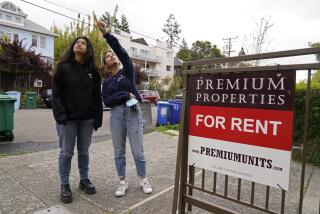No tears for the housing bubble
- Share via
Buried on Page 17 of the Business section is a story (“Housing Costs Outpace Incomes,” Oct. 12) that identifies the bottom card in the house of cards upon which our financial system has relatively recently rested: the fact that between 1996 and 2006 mortgage payments rose 46%, utilities 43%, property taxes 66% and homeowner insurance 83%, while homeowner incomes increased only 36.3%. All of the above expenses, with the possible exception of utilities, are driven by home prices.
Clearly, what needs to happen is a reduction of home prices back down to 1996 levels.
That can most efficiently be achieved by allowing the market to adjust itself. Thus, each bank can decide for itself if it wants to foreclose or voluntarily renegotiate its nonperforming loans. Foreclosures will automatically eliminate the bad loans and force the banks to sell the houses at prices commensurate with people’s incomes. The reduction in home prices, in turn, will result in reduced taxes, insurance and mortgage payments.
John Fessler
Chino Hills
More to Read
Inside the business of entertainment
The Wide Shot brings you news, analysis and insights on everything from streaming wars to production — and what it all means for the future.
You may occasionally receive promotional content from the Los Angeles Times.










